
Royal Enfield Himalayan 650: 4 Reasons Why We Want One
- Jul 27, 2018
- Views : 51615


Engine: The Himalayan gets an all-new, air-cooled single cylinder engine displacing 411cc and uses overhead camshafts now to aid efficiency and performance. The engine is codenamed LS410, denoting long stroke and the engine’s displacement. The outputs for the engine are 24.8PS which is produced at 6500rpm and 32Nm of torque produced between 4000 and 4500rpm. The engine uses an oil cooler, which is a first in the history of the brand, and it ensures the oil lubricating the engine stays cooler, thereby optimising its efficiency. Long stroke engines are typically known to not rev high, which is why the Himalayan’s motor redlines at just under 7000rpm. Long stroke engines are also known to rev slower, while offering more torque at lower revs. The Himalayan’s engine displays these characteristics perfectly, offering good bottom end grunt and it does not need to be revved hard to extract performance.
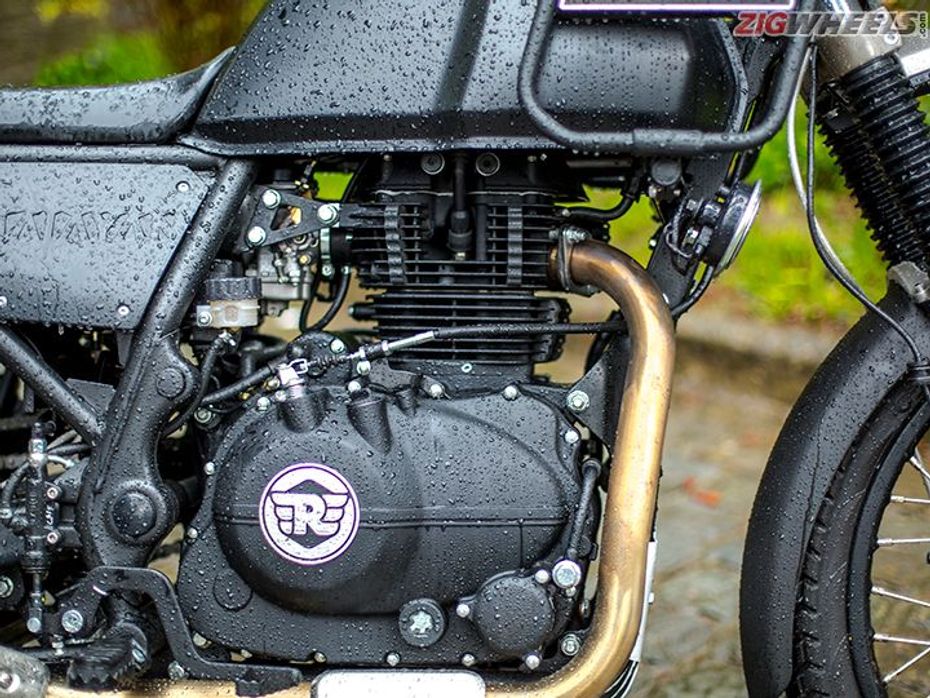
More importantly, the LS410 is probably the smoothest engine from Royal Enfield yet. The manufacturer has used a counter balancer to that effect, which aids smoothness. The engine has a smooth feel even close to its redline, unlike some of the earlier Royal Enfield engines that were prone to cause excessive vibration, especially at the footpegs and handlebars. The refinement of the motor should thus be a boon for those keen on spending long hours in its saddle, since amongst other things, it is the vibration from the engine of a motorcycle that can cause fatigue when riding for hours at a stretch. Royal Enfield claims the primary target audience for the motorcycle is the buyer upgrading from a smaller, say 150cc motorcycle, and hence the performance has been kept such that it is not overwhelming for such riders. That said, experienced riders will feel the need for some more performance. Extracting more power from the engine shouldn’t be a huge ask though, given the immense tuning potential of Royal Enfield’s engines. It wouldn’t be surprising to see a well-tuned Himalayan producing in excess of 30PS then, which should make it even more fun to ride.
What’s more, Royal Enfield is claiming a range of 400-500km from the 14-litre fuel tank, which means you could expect an efficiency of 30-35kmpl in the real world with the all-new motor.
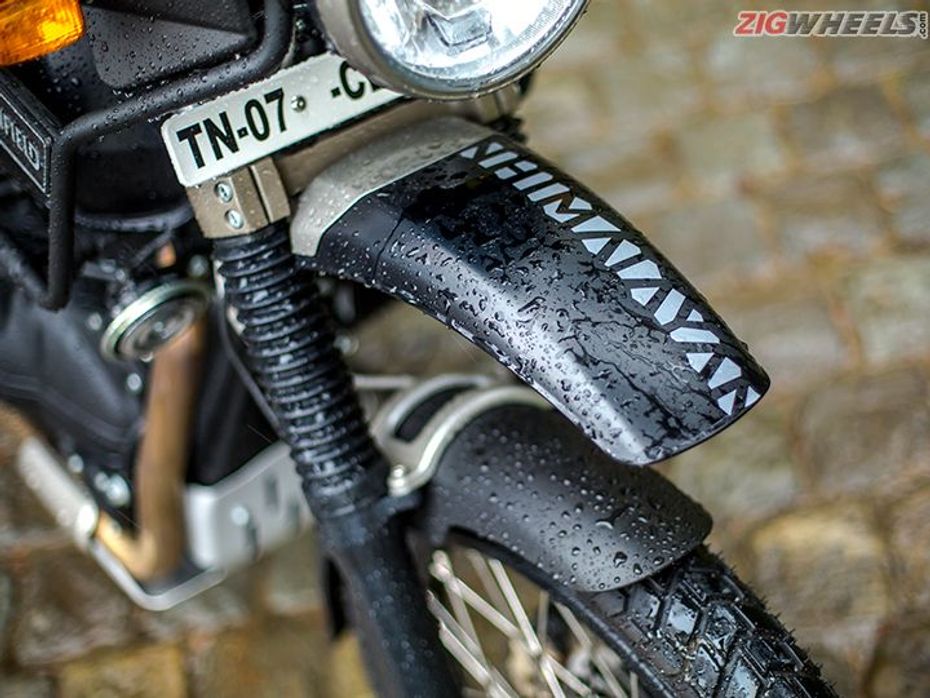
Suspension: The Himalayan uses all-new cycle parts including the suspension. Upfront, 41mm conventional forks are employed, offering travel of up to 200mm. This is great considering the positioning of the bike as an adventure tourer – these bikes are meant to be ridden fast over rough terrain and higher travel is always welcome off tarmac. The suspension has been tuned really well, as it soaks in bumps, potholes and undulations nicely. The forks offer you the confidence to keep the throttle wide open even over bad surfaces, taking almost everything in its stride.
At the back, the Himalayan uses a monoshock, which is again a first for a Royal Enfield. The monoshock uses a linkage system, thereby allowing finer adjustments of the setup and better handling. The monoshock offers travel of up to 180mm and works very well, just like the front forks in providing a plush ride while offering great confidence while pushing the bike hard. We rode the bike over a range of surfaces like smooth tarmac, broken, pothole ridden roads, dirt, slush, snow, rocks etc and the cushioning from the suspension at both ends of the Himalayan is commendable, while offering lots of confidence so you do not have to back-off the throttle. The suspension plays a huge role in making the Himalayan the best handling Royal Enfield till date.
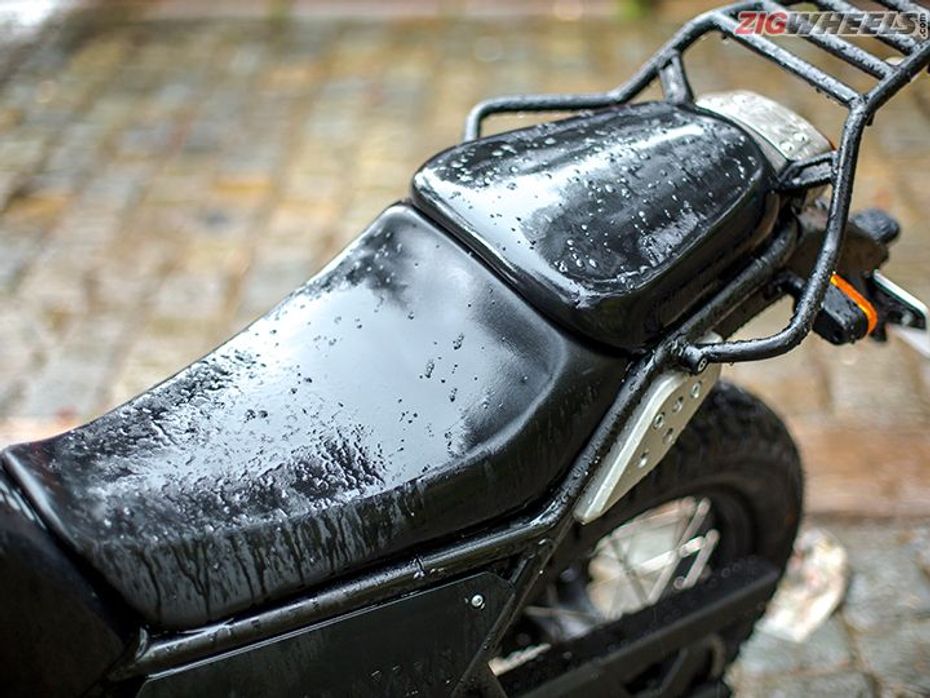
Seat: A touring motorcycle demands a comfortable seat, and Royal Enfield has ensured the Himalayan’s saddle is supremely comfortable. The intensity of the foam, the shape of the seat and the contour of the seat cover have been perfected well to ensure your backside stays relaxed even after long hours of continuous riding. The seat has been shaped well too, and is wide enough to accommodate riders of various sizes. The pillion seat is stepped, and is higher than the rider’s seat, and provides a nice support to the rider’s tail bone, which again adds to the comfort it offers.

Brakes: The Himalayan employs a 300mm disc in front and a 240mm disc at the rear, with braided steel lines. The brakes are perhaps the best we’ve experienced on a Royal Enfield yet, as they offer ample retardation. The front brake offers a lot of confidence with its progressive feel, which should inspire a lot of confidence to those graduating from smaller, lighter motorcycles. The rear brake is quick to offer retardation as well, though it tends to lock the wheel quicker than you would expect. However, given the progressive feel and confidence from the front brake, I really don’t see much need to use the rear brake, even on loose surfaces.
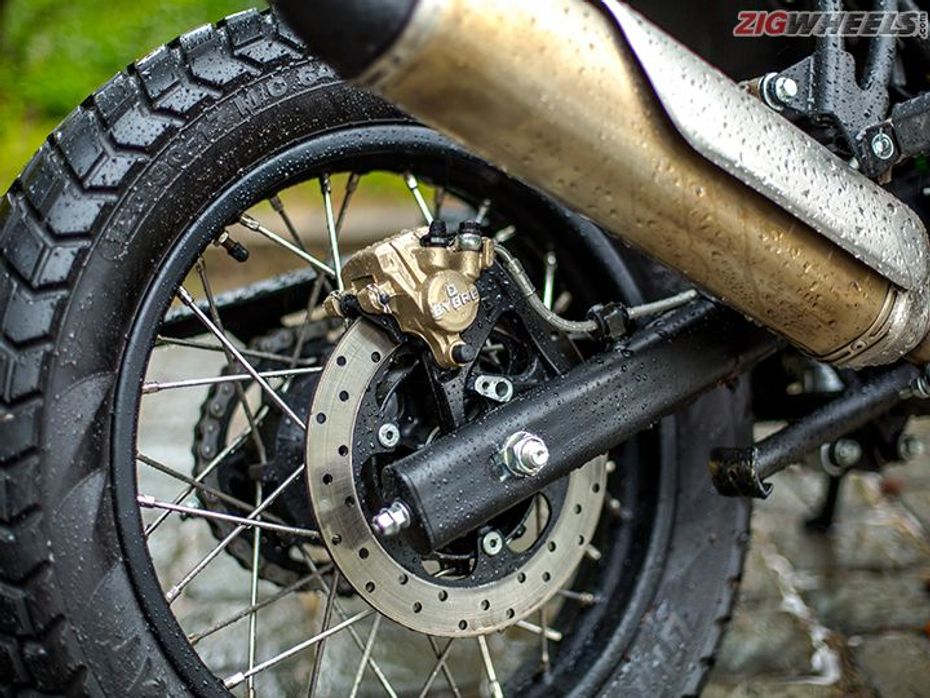
Wheels and tyres: The Himalayan uses a 21-inch front wheel and a 17-inch at the rear, which makes for a likeable package, especially when riding off tarmac. The large front wheel allows you ride climb inclines with relative ease, and should again act as a confidence booster for newer riders. The Himalayan comes shod with dual purpose tyres from Ceat, which do their job well. As opposed to the general perception about dual purpose tyres that look more like off-road ones not providing good grip on tarmac, especially wet, the Ceats worked brilliantly.
I was surprised at the grip levels provided by the tyres even on the wet, snowy roads around Shimla where we rode the motorcycle. The tyres allowed me to brake reasonably hard around corner and offered enough confidence to lean in, hanging off slightly, as if riding a street bike. Off tarmac, the tyres work well as one would expect, offering enough grip to plough the front end through the tricky stuff and not have to chop the throttle abruptly due to the front end trying to give away.

Instrumentation: The Himalayan has the most comprehensive equipment we’ve seen on any Royal Enfield motorcycle till date. A thoughtfully designed console with as many as four pods offers a lot of information, and everything is stuff that will help you on a ride in the remotest of places. The biggest dial is for the speedometer, with a slightly smaller dial for the tachometer to its right. Two smaller dials sit below, once of which is the fuel gauge, while the one on the right is a digital screen that actually is a compass, displaying the direction you are riding in. The large speedometer dial incorporates a digital gear indicator, yet another first, a clock, ambient temperature display, odometer, two trip meters, average speed display and a side stand indication as well.
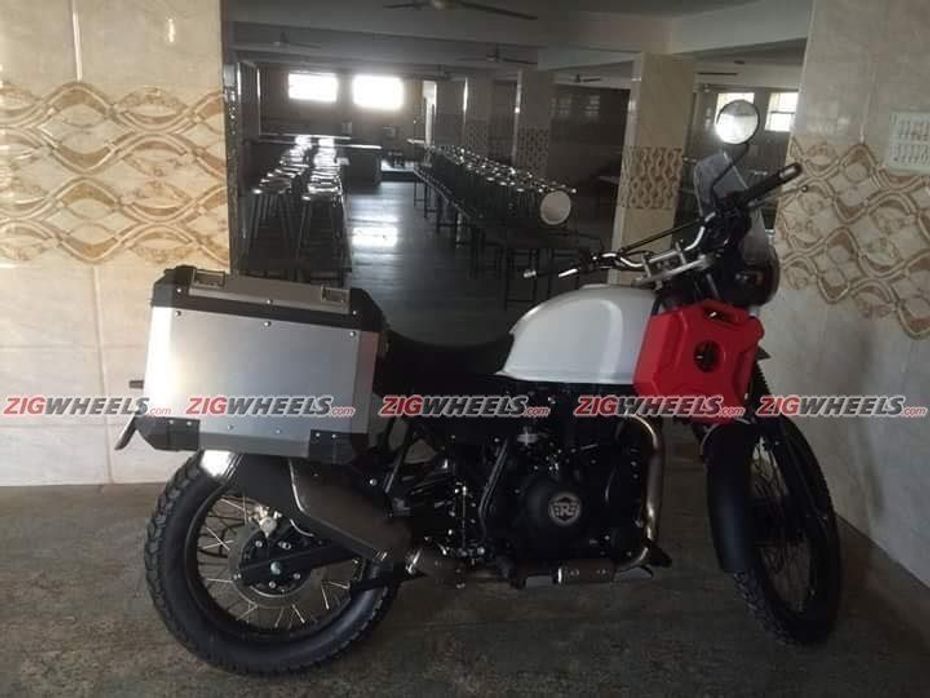
Accessories: Royal Enfield has a whole range of accessories on offer for the Himalayan. The manufacturer has in fact worked hard at designing and perfecting a set of hard metal panniers for the motorcycle that can hold around 20-25kg of stuff each, meaning a total carrying capacity of 40-50kg from the panniers alone. Apart from that there’s thoughtfully designed mounts all round, should you want to carry a tail bag or tie down your stuff to the motorcycle with bungee cords. Interestingly, the Himalayan also gets mounts for jerry cans in front, on both sides of the fuel tank, and these should allow you to carry additional fuel when riding in remote places.
Apart from these, the manufacturer has launched a complete new line of apparel and protective riding gear, right from the basic riding denims and casual boots with some protection to purpose built gear like winter riding gloves and touring jackets and pants that are completely water-proof, use breathable fabric and get thermal liners inside as well to keep you warm even in the rain or snow. The jackets and pants have been made by Rev’it! which is a highly reputed brand globally in the world of protective riding gear.
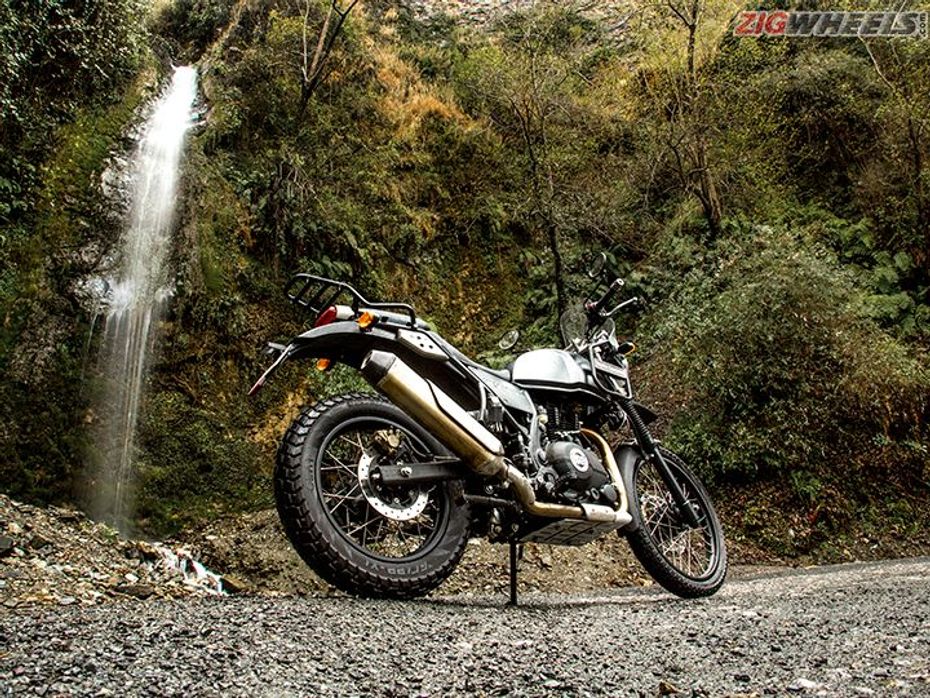
With features and equipment like these, Royal Enfield has tried to offer what is easily the country’s most affordable, purpose-built adventure touring motorcycle. The bike holds a lot of promise, and Royal Enfield is in fact wanting to offer the Himalayan as a do-it-all motorcycle. It could be your daily ride to office, and without having to change a thing, you could just start riding it to almost anywhere, especially the land that gives it its name, the Himalayas!

Royal Enfield Himalayan 650: 4 Reasons Why We Want One

2018 Royal Enfield Himalayan Odyssey Flagged Off

Royal Enfield Himalayan Gets Termignoni Exhaust

Monsoon Motorcycle Tips: 5 Ways To Ride Safely In The City

7 Most Fuel Efficient 300-400cc Motorcycles - TVS Apache RR 310,...

Himalayan To Be The Only Royal Enfield To Get Dual-Channel ABS

Royal Enfield Himalayan Sleet Launched In India

Royal Enfield Himalayan To Get New Colour

2017 Royal Enfield Tour Of Uttarakhand : Ride To The Land Of Gods
 Hero XPulse 200 4V
Hero XPulse 200 4V
 TVS Apache RR 310
TVS Apache RR 310
 Bajaj Dominar 400
Bajaj Dominar 400
 KTM 390 Adventure
KTM 390 Adventure
 Royal Enfield Interceptor 650
Royal Enfield Interceptor 650
India's largest automotive community
 Royal Enfield Hunter 350
Rs. 1.49 Lakh
Royal Enfield Hunter 350
Rs. 1.49 Lakh
 Royal Enfield Classic 350
Rs. 1.93 Lakh
Royal Enfield Classic 350
Rs. 1.93 Lakh
 Royal Enfield Continental GT 650
Rs. 3.19 Lakh
Royal Enfield Continental GT 650
Rs. 3.19 Lakh
 Royal Enfield Bullet 350
Rs. 1.73 Lakh
Royal Enfield Bullet 350
Rs. 1.73 Lakh
 Royal Enfield Meteor
Rs. 2.05 Lakh
Royal Enfield Meteor
Rs. 2.05 Lakh